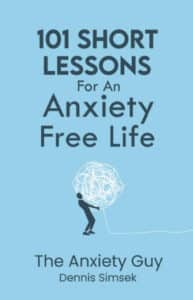If you take an objective look at those anxious thoughts you have right now, you will soon realize that they are almost always based upon guesswork and exaggeration. Thinking about a situation in a realistic, more balanced way will help to break the vicious circle of anxiety and those anxious thoughts. To develop a more confident, less anxious thoughts of thinking it is helpful to practice thought challenging. This extremely effective technique becomes easier and more powerful the more you practice it.
First, you need to ask yourself the following five questions:
· Are there any good reasons to be so worried?
· Are there any good reasons not to be so worried?
· Is there another way I could look at this?
· What is the worst that could happen?
· What can I do about it?
Now let’s look more closely at each of those questions in turn.
Are there any good reasons to be so worried?
When answering this question, ask yourself:
· What are the facts of this situation?
· Do those facts support my thoughts or contradict them?
· Would someone else think that my thoughts were based on
facts?
Are there any good reasons not to be so worried?
Now you need to ask yourself if there are any reasons why you should NOT be thinking this these anxious thoughts. You may find some clues in your answers to the first question as to why you need not be worried. Alternatively, you could think of things that have happened before that contradict your current worry, or think about times you have worried about something similar and turned out to be wrong.
You can also try asking yourself these questions:
· Am I trying to predict the future here?
· Am I jumping to conclusions?
· Am I overestimating the likelihood of this happening?
· Am I trying to guess what other people think?
· Will this problem matter one week/month/year from now?
Is there another way I could look at this?
Whatever it is that is causing your anxious thoughts here, there is almost always another, more helpful way of looking at the situation. When you are anxious however, it can be almost impossible to see the bigger picture. It may help therefore, to look at this from another person’s point of view. You could ask yourself what a close friend whom you trust would think in your situation. Or you could think about what you might say to a friend in a similar situation. The point here is to try to stand outside your anxious thought and to see the situation from a more objective angle.
You need to make sure that the alternatives you come up with are realistic and to decide whether these are more helpful than the original thought which was worrying you.
What is the worst that could happen?
Almost everyone who suffers from these anxious thoughts thinks about the bad things that could happen in the future. These anxious thoughts only make you more anxious so the natural response is to try to push them out of your mind before really examining them carefully. The important thing is, however, to confront those thoughts and think them through to their logical conclusion. Ask yourself ‘What really is the worst that could happen?’ This might show you that:
· Your worst fear is so exaggerated that it is highly unlikely, or even impossible, that it would ever happen.
· Your worst fear may be far less likely to happen than you previously predicted.
· Even if your worst fear does happen, you may be able to cope with it far better than you previously imagined.
Once you have worked out what your worst fear is, ask yourself how likely it is that this would actually happen. That might be all you need to put that fear into perspective. You can take things a step further and ask yourself how you would cope if this happened. In this case, don’t underestimate yourself or your capabilities. As you will see in the final question, you probably have all the skills and experience you need to cope in difficult situations.
With this final question regarding your anxious thoughts, ask yourself:
· What skills do I have that might help me cope with this situation?
· What past experience do I have that might help me cope with this situation?
· What advice would I give to a friend in a similar situation?
· Who can I ask for help or advice?
· Do I have all the facts I need to deal with this situation? If not, how can I find out what I need to know?
It is important that you ask yourself what you can do in the immediate future to deal with a specific situation, and then come up with a plan of action. To help you do this, you might like to follow the six steps of problem solving set out below:
1. Define the problem. Instead of just going over and over the anxious thoughts in your head, try to be specific. Decide exactly what the problem
is, breaking it down into smaller problems if necessary.
2. Make a list of your resources and possible solutions. Have you solved a similar problem in the past? Do you have any skills, knowledge or personal strengths that will help you solve this problem? Is there anyone who could help you? Write down as many solutions as you can think of and don’t worry about how unlikely or silly they might seem.
3. Choose a solution from your list. Read through the solutions you have come up with and decide how likely each one is to succeed. Consider also how much time and effort each would take and whether or not you would need to enlist the help of a friend. Then pick a solution you are going to put into action. You don’t have to choose one that will solve the whole problem – as long as it gets you moving in the right direction, it’s a good choice.
4. Make a plan. Break the solution you have chosen down into small, manageable steps. Make each step very clear and specific. Decide which steps you are going to take first and set out your plan in order.
5. Do it. Try out your solution, even if it is only a first step in solving your problem.
6. Review the outcome. If it works, that’s great. Congratulate yourself and remember it for next time. If it doesn’t work, review what happened – do you need to rework your plan? Do you need to try again? Remember that even if you haven’t initially solved your problem you are at least dealing with it. This in itself will help you towards your successful solution.
In conclusion, make your goal to begin challenging your anxious thoughts more anxious thoughts . See it as a little child starving for your attention, attention that you will refuse to give it. The more you begin challenging your anxious thoughts, the clearer you’ll be able to see that your current fears hold no real truth behind them.




















This help me. Really Good. Send me more info. Thanks
Glad it helped 🙂
Very good. I work with people with anxiety. Am going to print this for them.Would only add one portion, though perhaps it belongs in a different section. It would be: Eliminate blame and move on. In other words, I find clients dwell on self-blame and this heightens anxiety and creates self-doubt for determining a new set of actions.. So we first focus on what created the problem and how to avoid a similar occurrence “Next time, I will . . .”. THEN we can move forward with a plan like you outline. Just a thought. . .
Very CBT I like it Trina thanks for sharing.
Through the last 15 years, I have found EXercise is a Wonderful way to cope w/Anxiety! Even 10min of Simple stretches!
Very true.